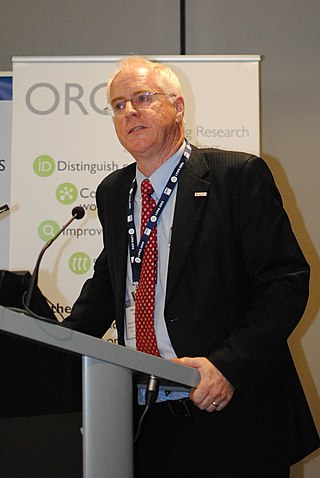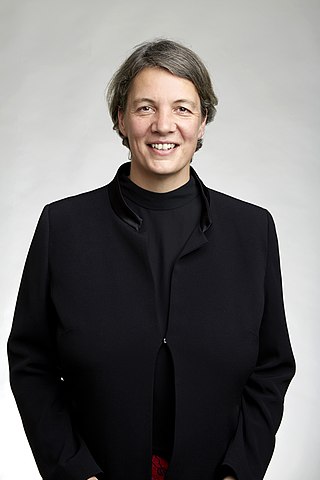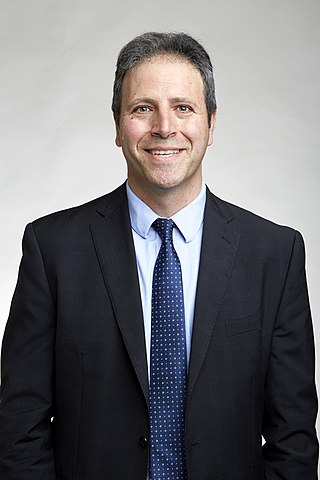Michelle Louise Coote | |
|---|---|
| Alma mater | University of New South Wales |
| Scientific career | |
| Thesis | The origin of the penultimate unit effect in free-radical copolymerisation (1999) |
Michelle Louise Coote FRSC FAA is an Australian polymer chemist. She has published extensively in the fields of polymer chemistry, radical chemistry and computational quantum chemistry. She is an Australian Research Council (ARC) Future Fellow, Fellow of the Royal Society of Chemistry (FRSC) and Fellow of the Australian Academy of Science (FAA).
Coote is a professor of chemistry in the Australian National University (ANU) College of Physical and Mathematical Sciences. [1] She is a member of the ARC Centre of Excellence for Electromaterials Science [2] and past chief investigator in the ARC Centre of Excellence for Free-Radical Chemistry and Biotechnology. [3]
Professor Michelle Coote completed a B.Sc. (Hons) in Industrial Chemistry at the University of New South Wales in 1995. During her degree she spent 15 months working in the chemical industry, "but it made me realise that my real interest was in a career in pure chemical research. So, I went back to university and ended up graduating in 1995 with the university medal." [4] Graduating in 2000 with a PhD in Polymer Chemistry from UNSW, Coote took out major awards including the Cornforth Medal from the Royal Australian Chemical Institute (RACI) and the prize for young scientists from the International Union of Pure and Applied Chemistry (IUPAC) for her PhD thesis 'The origin of the penultimate unit effect in free-radical copolymerisation'. [5]
Coote left Australia for the UK in September 1999 to take up a Post Doctoral Research Role in polymer physics focusing on neutron reflectivity within the Polymer Interdisciplinary Research Centre [6] at The University of Durham. [7]
Coote returned to Australia in 2001 and joined the Research School of Chemistry, Australian National University as a postdoctoral fellow with Leo Radom. It was during this time that she began to build a reputation in computational chemistry, and she established an independent research group on the computer-aided chemical design [8] at ANU in 2004.
Awarded an ARC Future Fellowship in 2010, Coote focused on a computer-guided experimental approach to understand and control the stereochemistry of free-radical polymerisation. [9] Since then, Coote has received a number of grants from the Australian Research Council, [10] including the Georgina Sweet Australian Laureate Fellowship in 2017. [11] Today, her research interests span several broad areas of fundamental and applied chemistry: stereocontrol in free-radical polymerisation, [12] polymer degradation and stabilisation, [13] radical stability [14] and, most recently, electric field effects on chemical reactivity. [15]
Coote became the first female Professor of Chemistry at ANU in 2011. [16]
Coote received numerous awards, including the Rennie Memorial Medal (2006), David Sangster Polymer Science and Technology Achievement Award (2011) and H.G. Smith medal (2016) from the Royal Australian Chemical Institute, [17] the Le Fevre Memorial Prize of the Australian Academy of Science (2010) [18] and the Pople Medal of the Asia-Pacific Association for Theoretical and Computational Chemistry (2015). [19] She was also named the 2019 Schleyer lecturer, becoming the first female and the second Australian since the series beginning in 2001. [20]
Coote was elected a Fellow of the Royal Society of Chemistry in March 2013. [21] She was elected a Fellow of the Australian Academy of Science in 2014 for developing and applying accurate computational chemistry for modelling radical polymerization processes. [22] Coote gave her New Fellows' Presentation in July 2014. [23]
Coote was recognised by ANU in 2012 as part of their International Women's day celebrations for her achievements as a role model as the first female professor of chemistry at ANU and for inspiring, mentoring and motivating female undergraduate and postgraduate students in the sciences. [24]
In December 2016, Coote was appointed as the first Australian Associate Editor of the premier Chemistry journal, the Journal of the American Chemical Society. [25]
The Australian Research Council (ARC) is the primary non-medical research funding agency of the Australian Government, distributing more than A$800 million in grants each year. The Council was established by the Australian Research Council Act 2001, and provides competitive research funding to academics and researchers at Australian universities. Most health and medical research in Australia is funded by the more specialised National Health and Medical Research Council (NHMRC), which operates under a separate budget.
Craig Jon Hawker is an Australian-born chemist. His research has focused on the interface between organic and polymer chemistry, with emphasis on the design, synthesis, and application of well-defined macromolecular structures in biotechnology, microelectronics, and surface science. Hawker holds more than 45 U.S. patents, and he has co-authored over 300 papers in the areas of nanotechnology, materials science, and chemistry. He was listed as one of the top 100 most cited chemists worldwide over the decade 1992–2002, and again in 2000–2010.

Keith Alexander Nugent FAA is an Australian physicist. He is the Deputy Vice-Chancellor of the Australian National University (ANU) in Canberra.

Krzysztof "Kris" Matyjaszewski is a Polish-American chemist. He is the J.C. Warner Professor of the Natural Sciences at the Carnegie Mellon University Matyjaszewski is best known for the discovery of atom transfer radical polymerization (ATRP), a novel method of polymer synthesis that has revolutionized the way macromolecules are made.
Gordon Wallace, AO, FAA, FTSE, FRACI is a leading scientist in the field of electromaterials. His students and collaborators have pioneered the use of nanotechnology in conjunction with organic conductors to create new materials for energy conversion and storage as well as medical bionics. He has developed new approaches to fabrication that allow material properties discovered in the nano world to be translated into micro structures and macro scopic devices.

Michelle Yvonne Simmons,, is a Scientia Professor of Quantum Physics in the Faculty of Science at the University of New South Wales and has twice been an Australian Research Council Federation Fellow and is an Australian Research Council Laureate Fellow. She is the Director of the Australian Research Council Centre of Excellence for Quantum Computation & Communication Technology and is recognised internationally as the creator of the field of atomic electronics. She was the inaugural editor-in-chief of npj Quantum Information, an academic journal publishing articles in the emerging field of quantum information science. On 25 January 2018, Simmons was named as the 2018 Australian of the Year for her work and dedication to quantum information science. On 10 June 2019, Simmons was appointed an Officer of the Order of Australia (AO) in the 2019 Queen's Birthday Honours in recognition of her "distinguished service to science education as a leader in quantum and atomic electronics and as a role model."
Martina Heide Stenzel is a Professor in the Department of Chemistry at the University of New South Wales (UNSW). She is also a Royal Australian Chemical Institute (RACI) University Ambassador. She became editor for the Australian Journal of Chemistry in 2008 and has served as Scientific Editor and as of 2021, as Editorial Board Chair of RSC Materials Horizons.
Margaret Harding is an Australian chemist and educator who is currently Deputy Vice-Chancellor (Research) at The Australian National University (ANU). She is an expert in medicinal and biomolecular chemistry, with special research interests in the areas of antifreeze proteins and ligand-DNA interactions.
Kerrie Mengersen is an Australian statistician. Since 2016, she has been Distinguished Professor of Statistics at Queensland University of Technology in the Science and Engineering Faculty.

David Henry Solomon is an Australian polymer chemist. He is best known for his work in developing Living Radical Polymerization techniques, and polymer banknotes.

Rose Amal is an Australian chemical engineer, currently serving as Scientia Professor and ARC Laureate Fellow in the School of Chemical Engineering at the University of New South Wales, Australia, where she is the director of the Particles and Catalysis Research Group. Previously she was Director of the ARC Centre of Excellence for Functional Nanomaterials (2010–2013). From 2012 to 2015 she was named in the Engineers Australia list of Australia's Top 100 Most Influential Engineers. In 2014 she became the first female engineer elected a Fellow of the Australian Academy of Science.

Susanne von Caemmerer FRS is a professor and plant physiologist in the Division of Plant Sciences, Research School of Biology at the Australian National University; and the Deputy Director of the ARC Centre of Excellence for Translational Photosynthesis. She has been a leader in developing and refining biochemical models of photosynthesis.

Ajayan Vinu is a material scientist. He is currently the Global Innovation Chair Professor for Advanced Nanomaterials and the director of Global Innovative Centre for Advanced Nanomaterials (GICAN), The University of Newcastle since October 2017 which houses more than 60 researchers including PhD students and staff. Before moving to the University of Newcastle, he was a professor of Nanomaterials at the University of South Australia from 2015-2017. and also worked at the University of Queensland as a Professor and ARC Future Fellow from 2011-2015. He is well known in the field of mesoporous carbon nitride and was the first one to introduce porosity in carbon nitride materials which find applications in different areas of research including catalysis, energy storage and conversion and carbon dioxide capture, and photocatalytic water splitting for hydrogen generation.
Joy Damousi, is an Australian historian and Professor and Director of the Institute for Humanities and Social Sciences at Australian Catholic University. She was Professor of History in the School of Historical and Philosophical Studies at the University of Melbourne for most of her career, and retains a fractional appointment. She was the President of the Australian Academy of the Humanities from 2017 to 2020.

Francesco Caruso is Melbourne Laureate Professor and National Health and Medical Research Council (NHMRC) Senior Principal Research Fellow in the School of Chemical and Biomolecular Engineering at the University of Melbourne, Australia. Caruso is deputy director of the Australian Research Council (ARC) Centre of Excellence in Convergent Bio-Nanoscience and Technology.
Christopher Barner-Kowollik FAA, FQA, FRSC, FRACI is an Australian Research Council (ARC) Laureate Fellow, the Senior Deputy Vice-Chancellor and Vice-President (Research) of the Queensland University of Technology (QUT) and Distinguished Professor within the School of Chemistry and Physics at the Queensland University of Technology (QUT) in Brisbane. He is the Editor-in-Chief of the Royal Society of Chemistry (RSC) journal Polymer Chemistry, a principal investigator within the Soft Matter Materials Laboratory at QUT and associate research group leader at the Karlsruhe Institute of Technology (KIT).
Maria Forsyth is an Australian chemist. She is a research professor at the University of the Basque Country and an Alfred Deakin Fellow at Deakin University in Victoria, Australia where she holds the Chair in Electromaterials and Corrosion Sciences.

Elanor H. Huntington is Executive Director of Digital, National Facilities & Collections at the Commonwealth Scientific and Industrial Research Organisation and a Professor of Quantum Cybernetics at the Australian National University. She led a research program in the Australian Research Council Centre of Excellence for Quantum Computation and Communication Technology.
Anita J. Hill is an Australian researcher in materials and process engineering. She is a former Chief Scientist of the Commonwealth Scientific and Industrial Research Organisation (CSIRO), and the current Executive Director of Future Industries at CSIRO. Her research focuses on the transport of atoms, ions and small molecules in condensed matter, notably using positron annihilation spectroscopy.